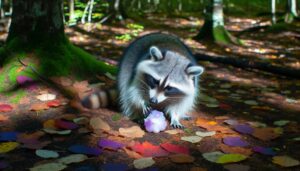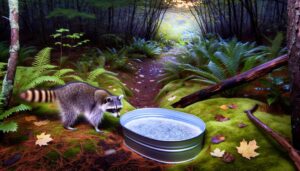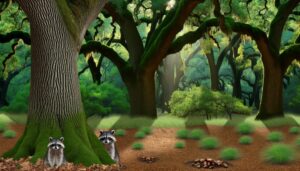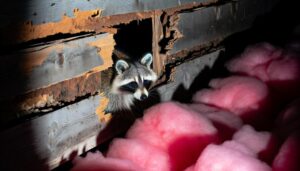Do Raccoons Live in Texas Habitats?
Yes, raccoons (Procyon lotor) are prevalent throughout Texas. Adult raccoons weigh between 8 to 20 pounds and measure 24 to 38 inches in length.
They thrive in various habitats, including urban areas, riparian zones, and deciduous forests. Population densities range from 20 to 50 individuals per square mile.
These omnivores exploit diverse food sources such as invertebrates, fruits, and cultivated crops. Breeding occurs from January to March, with a 63-day gestation period.
Seasonal behavior includes increased nocturnal activity in warmer months. For information on their impacts and conservation strategies, investigate further into their unique ecological role.
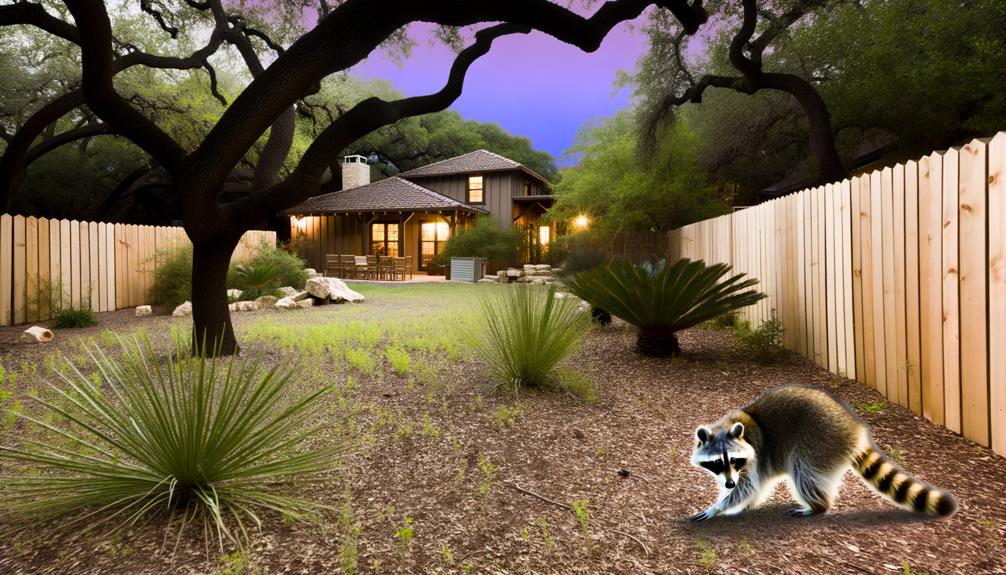
Key Takeaways
- The common raccoon (Procyon lotor) is prevalent throughout Texas.
- Raccoons adapt well to both urban and rural environments in Texas.
- They prefer habitats with abundant food, water, and natural shelters.
- Raccoon population density in Texas ranges from 20 to 50 individuals per square mile.
- Conservation efforts in Texas include habitat preservation and disease management.
Raccoon Species in Texas

In Texas, the most prevalent raccoon species is the common raccoon (Procyon lotor), characterized by its distinctive black facial mask and ringed tail. This species exhibits considerable adaptability, thriving in various environments across the state.
According to studies conducted by the Texas Parks and Wildlife Department, the population density of Procyon lotor in Texas is estimated to be between 20 to 50 individuals per square mile in ideal habitats. Morphologically, adult common raccoons typically weigh between 8 to 20 pounds and measure 24 to 38 inches in length, including the tail.
The species demonstrates nocturnal behavior, which is supported by their advanced night vision and tactile sensitivity. Genetic analyses reveal minimal subspecies differentiation within the state, indicating a relatively uniform population.
Preferred Habitats
Raccoons in Texas exhibit a preference for habitats that offer abundant food sources, water, and shelter, such as riparian zones, deciduous forests, and urban areas.
Riparian zones, characterized by proximity to rivers and streams, provide raccoons with ample water and diverse food options, including aquatic invertebrates and vegetation.
Deciduous forests offer seasonal availability of fruits, nuts, and insects, supporting raccoons' omnivorous diet.
Studies indicate that raccoon populations are densest in regions where these environmental factors converge, enhancing survival and reproductive success.
Additionally, raccoons utilize natural shelters, such as tree cavities and dense underbrush, to evade predators and extreme weather.
These habitat preferences underscore the species' adaptability to varied ecological conditions within Texas.
Urban Adaptations
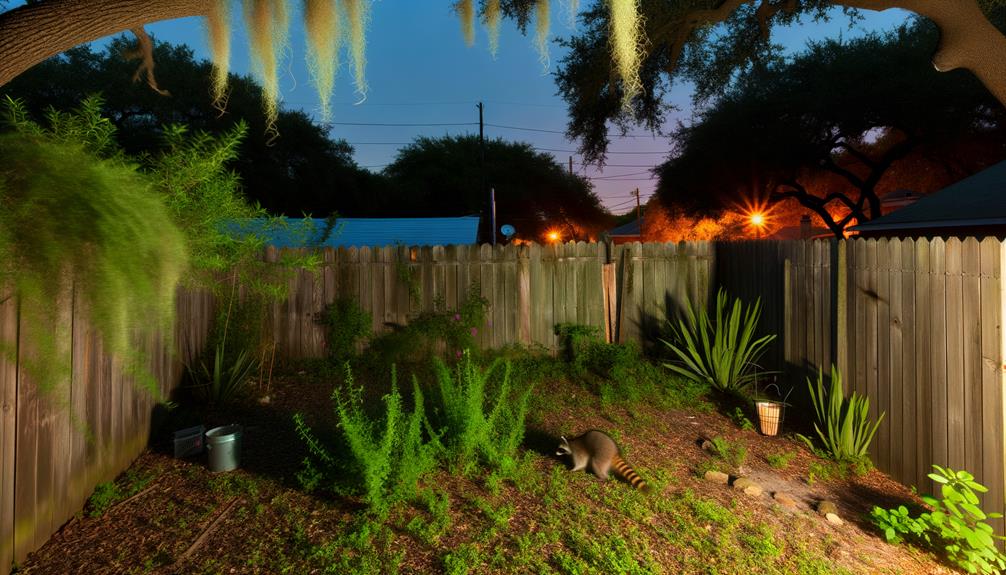
Raccoons in Texas exhibit remarkable urban adaptations. This is primarily evidenced by their utilization of abundant urban food sources and their ability to find shelter within city environments.
Studies indicate that raccoons frequently exploit anthropogenic food supplies, including garbage and pet food, leading to increased urban populations. Furthermore, their capacity to inhabit diverse urban structures, such as attics, sewers, and abandoned buildings, underscores their adaptability to metropolitan ecosystems.
Urban Food Sources
Urban environments provide raccoons with abundant food sources due to the prevalence of human-generated waste and accessible resources. Studies indicate that raccoons (Procyon lotor) exploit anthropogenic food, such as discarded food items from residential trash bins, commercial dumpsters, and public parks.
In cities like Houston and Dallas, raccoons have been observed foraging in these locations with a high success rate, contributing to their increased urban population densities. Analysis of raccoon diet in urban Texas reveals a significant proportion of processed foods, comprising up to 60% of their intake.
This dietary shift underscores raccoons' adaptability and opportunistic feeding behavior, facilitating their survival and reproduction in urban settings. Consequently, raccoons thrive in metropolitan areas, benefiting from the continuous availability of food resources.
Shelter in Cities
In parallel with their opportunistic feeding habits, raccoons exhibit remarkable adaptability in utilizing urban structures for shelter, frequently inhabiting attics, basements, and abandoned buildings to evade predators and harsh weather conditions. This behavior underscores their ecological plasticity, enabling them to thrive in metropolitan environments.
Empirical studies indicate that urban raccoons exhibit den site fidelity, often returning to the same shelter repeatedly. Additionally, thermal imaging data reveal that these mammals preferentially select insulated areas, optimizing energy conservation during colder months.
Urban raccoons' ability to exploit anthropogenic resources for nesting sites is a reflection of their resilience and adaptability. Consequently, their presence in Texas cities is not merely incidental but a result of complex behavioral adaptations to urban ecosystems.
Rural Raccoon Life
Adapted to diverse environments, Procyon lotor exhibits notable behavioral and ecological variations in rural Texas landscapes. In these regions, raccoons primarily inhabit wooded areas, riparian zones, and agricultural fields.
Their diet in rural settings is omnivorous, consisting of invertebrates, small vertebrates, fruits, and cultivated crops. Studies indicate that the density of raccoon populations in rural Texas can range from 0.5 to 3.5 individuals per square kilometer. Home range sizes also vary, averaging between 50 to 300 hectares, influenced by resource availability and habitat fragmentation.
Rural raccoons exhibit crepuscular activity patterns, with peak foraging occurring during dawn and dusk. The adaptability to different food sources and habitat types underscores their ecological plasticity in these environments.
Seasonal Behaviors
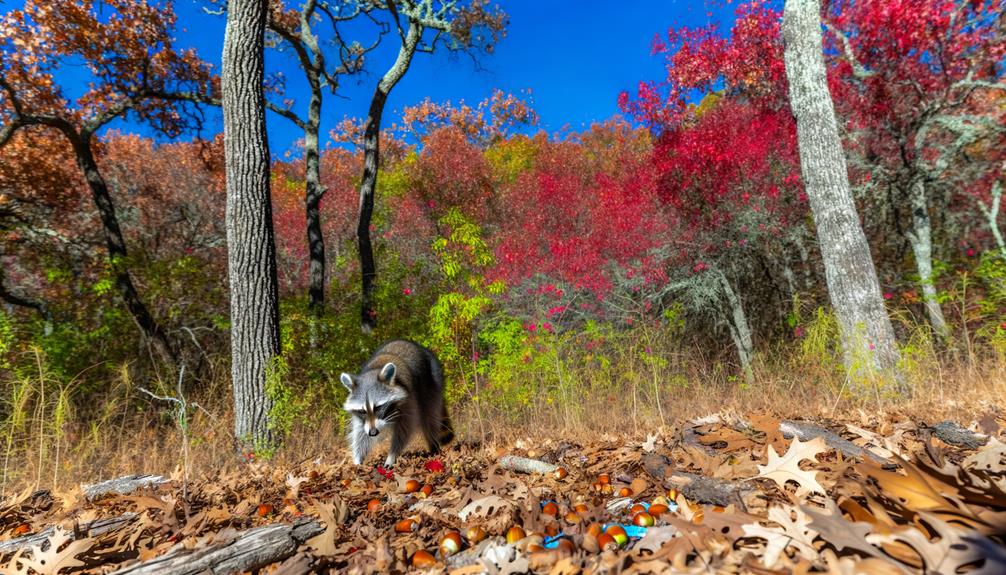
Understanding the seasonal behaviors of raccoons in Texas is imperative for comprehending their overall ecological patterns and adaptability. Raccoons exhibit notable behavioral changes in response to seasonal variations, which influence their survival and reproductive success.
Key seasonal behaviors include:
- Breeding Season: Typically occurring from January to March, with gestation lasting approximately 63 days.
- Denning Habits: Increased denning activity during colder months, utilizing tree cavities and abandoned structures.
- Activity Patterns: Higher nocturnal activity in warmer months due to increased prey availability.
- Molting: Seasonal fur shedding, primarily in spring, to adapt to fluctuating temperatures.
These behaviors highlight the raccoon's ability to modify their strategies in response to environmental cues, ensuring their resilience across Texas's diverse habitats.
Diet and Feeding Habits
Raccoons in Texas exhibit omnivorous dietary habits, consuming a diverse array of food sources that include fruits, nuts, insects, small mammals, and human refuse. This dietary flexibility allows them to thrive in various ecosystems, from urban areas to rural landscapes.
Studies reveal that raccoons' diets are seasonally variable, with increased consumption of fruits and nuts during autumn, which aids in fat accumulation for winter. Insects and small mammals are mainly consumed in spring and summer, providing necessary protein for growth and reproduction.
Additionally, raccoons frequently forage in human garbage, which constitutes a significant portion of their diet in urban environments. This opportunistic feeding behavior underscores their adaptability and resilience in the face of fluctuating food availability.
Interaction With Humans
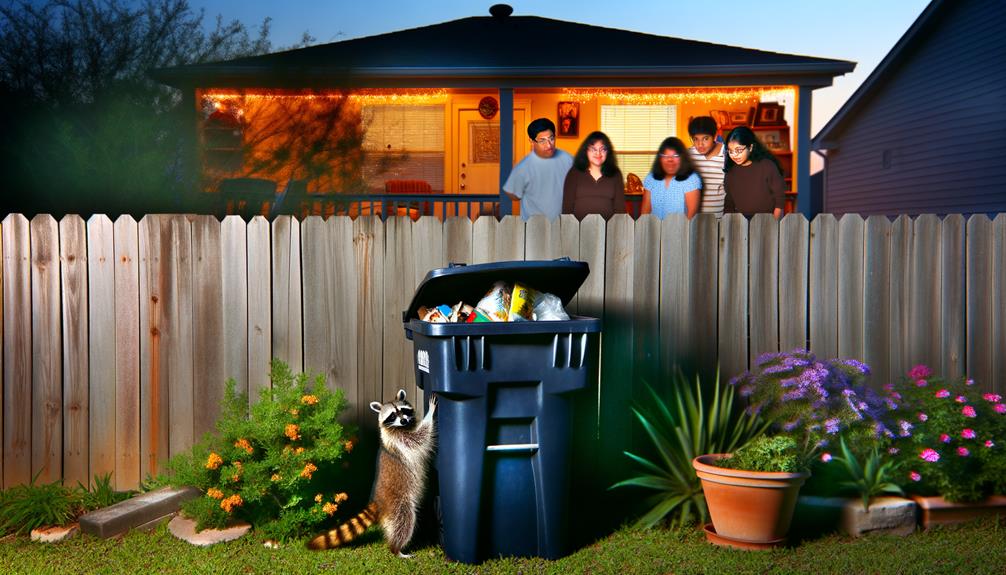
The opportunistic feeding behavior of raccoons often brings them into close contact with human populations, leading to various forms of interaction that can have both positive and negative outcomes.
Data indicates that these interactions can be categorized into four primary areas:
- Urban Foraging: Raccoons frequently scavenge in urban areas, locating food in trash bins and compost heaps.
- Garden Raiding: They often invade gardens and agricultural lands, causing significant crop losses.
- Pet Interaction: Encounters with domestic animals, sometimes resulting in conflicts or disease transmission.
- Nesting in Structures: Raccoons may nest in attics, basements, or other human-made structures, causing property damage.
Understanding these interactions aids in developing effective management strategies to mitigate adverse effects while promoting coexistence.
Common Challenges
Raccoons in Texas face significant challenges related to urban adaptation, where habitat fragmentation and human-wildlife conflict become prevalent. Additionally, these animals are vectors for diseases such as rabies and canine distemper, posing health risks to both wildlife and human populations.
Addressing these challenges requires data-driven strategies to mitigate negative impacts on raccoon populations and public health.
Urban Adaptation Issues
Amid increasing urbanization in Texas, raccoons face significant challenges such as habitat fragmentation, limited food resources, and heightened encounters with human activity. These issues can be detailed as follows:
- Habitat Fragmentation: Urban sprawl disrupts continuous habitats, leading to isolated raccoon populations.
- Limited Food Resources: Urban environments often lack the diverse food sources found in natural habitats, forcing raccoons to scavenge from human waste.
- Human-Raccoon Conflicts: Increased human activity escalates encounters, often resulting in negative interactions and potential harm to raccoons.
- Traffic Hazards: Urban areas pose significant risks due to vehicular traffic, contributing to higher mortality rates among raccoons.
These adaptation issues necessitate focused ecological and urban planning to mitigate adverse effects on raccoon populations.
Disease and Health Risks
Urban raccoon populations in Texas grapple with a range of zoonotic diseases and health risks, including rabies, canine distemper, and leptospirosis, which pose significant threats to both raccoon and human communities. These diseases are primarily transmitted through contact with infected bodily fluids, bites, or contaminated environments. Rabies, a fatal viral infection, requires immediate post-exposure prophylaxis. Canine distemper affects multiple organ systems and often results in neurological damage. Leptospirosis, a bacterial disease, can cause severe liver and kidney issues.
| Disease | Transmission Method | Health Impact |
|---|---|---|
| Rabies | Bites, saliva | Fatal without treatment |
| Canine Distemper | Direct contact, respiratory | Neurological, multi-organ damage |
| Leptospirosis | Contaminated water, soil | Liver and kidney dysfunction |
These health risks necessitate vigilant monitoring and public health interventions.
Conservation Efforts
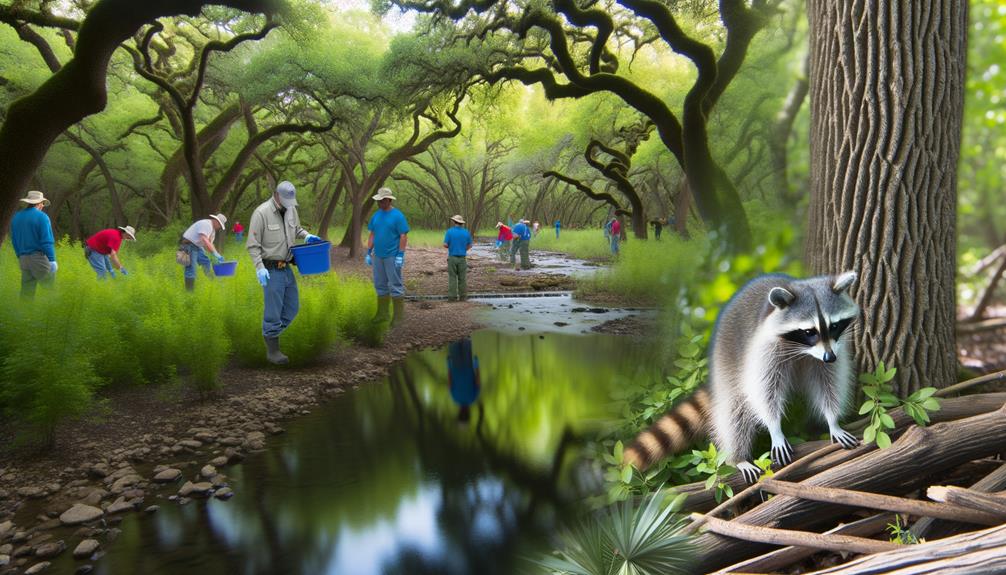
Efforts to conserve raccoon populations in Texas have focused on habitat preservation, disease management, and reducing human-wildlife conflicts.
Key strategies include:
- Habitat Preservation: Protecting and restoring natural habitats, such as wetlands and forests, to sustain raccoons have suitable living environments.
- Disease Management: Monitoring and controlling diseases like rabies and distemper to avert outbreaks that could devastate populations.
- Human-Wildlife Conflict Reduction: Implementing educational programs and urban planning measures to alleviate conflicts, thereby decreasing raccoon mortality from vehicle collisions and trapping.
- Research and Monitoring: Conducting ongoing studies to track raccoon population dynamics, health status, and ecological impacts, providing data-driven insights for efficient conservation actions.
These multifaceted efforts are crucial to maintain the ecological balance and health of raccoon populations in Texas.
Conclusion
Raccoons in Texas, spanning diverse habitats from urban landscapes to rural expanses, exhibit remarkable adaptability and resilience.
Their seasonal behaviors, omnivorous diet, and complex interactions with human populations underscore their ecological versatility.
However, challenges such as habitat fragmentation and human-wildlife conflicts persist, necessitating informed conservation efforts.
The raccoon's existence in Texas, much like a thread in a vast ecological tapestry, highlights the intricate balance between wildlife and human development, emphasizing the need for sustainable coexistence.


